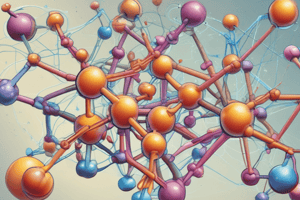Podcast
Questions and Answers
Which carbon position is involved in the epimerization process that leads to galactose?
Which carbon position is involved in the epimerization process that leads to galactose?
- Carbon 5
- Carbon 4 (correct)
- Carbon 2
- Carbon 1
What is the resulting sugar from epimerization at carbon 2?
What is the resulting sugar from epimerization at carbon 2?
- Mannose (correct)
- Galactose
- Glucose
- Fructose
What defines whether a sugar is classified as an aldose or a ketose?
What defines whether a sugar is classified as an aldose or a ketose?
- Type of functional group present
- Number of carbon atoms
- Presence of an aldehyde or ketone group (correct)
- Position of the hydroxyl group
Which of the following is an example of an aldose?
Which of the following is an example of an aldose?
Which pair of sugars are classified as isomers due to their structural differences?
Which pair of sugars are classified as isomers due to their structural differences?
How many isomers does glucose have based on its 4 asymmetric carbon atoms?
How many isomers does glucose have based on its 4 asymmetric carbon atoms?
Which type of isomerism is defined by the orientation of the -H and -OH groups around the subterminal carbon atom?
Which type of isomerism is defined by the orientation of the -H and -OH groups around the subterminal carbon atom?
What distinguishes alpha and beta anomers?
What distinguishes alpha and beta anomers?
What is the definition of epimers?
What is the definition of epimers?
Which of the following pairs consist of aldoses and ketoses?
Which of the following pairs consist of aldoses and ketoses?
What distinguishes epimers from one another?
What distinguishes epimers from one another?
Which of the following pairs represents the most important epimers of glucose?
Which of the following pairs represents the most important epimers of glucose?
On which carbon atoms do epimers mainly differ in glucose?
On which carbon atoms do epimers mainly differ in glucose?
Which statement is true regarding α and β anomers compared to epimers?
Which statement is true regarding α and β anomers compared to epimers?
What is the primary characteristic of monosaccharides?
What is the primary characteristic of monosaccharides?
Which of the following best describes the relationship between glucose and its epimers?
Which of the following best describes the relationship between glucose and its epimers?
Which of the following is NOT a classification of monosaccharides?
Which of the following is NOT a classification of monosaccharides?
How are monosaccharides categorized?
How are monosaccharides categorized?
What is the minimum number of carbon atoms for a monosaccharide to be classified as a pentose?
What is the minimum number of carbon atoms for a monosaccharide to be classified as a pentose?
Which of the following represents the highest number of carbon atoms in a monosaccharide?
Which of the following represents the highest number of carbon atoms in a monosaccharide?
Which type of monosaccharide contains a ketone group?
Which type of monosaccharide contains a ketone group?
Which of the following is classified as an aldose?
Which of the following is classified as an aldose?
Which of the following compounds is NOT an example of a ketose?
Which of the following compounds is NOT an example of a ketose?
What key functional groups differentiate aldoses from ketoses?
What key functional groups differentiate aldoses from ketoses?
Which of the following is a correct pairing of monosaccharide and its classification?
Which of the following is a correct pairing of monosaccharide and its classification?
Flashcards are hidden until you start studying
Study Notes
Isomers
- Glucose has 4 asymmetric carbon atoms resulting in 16 possible isomers
Types of Isomerism
- D and L isomers: based on the orientation of -H and -OH groups around the subterminal carbon atom
- Alpha and Beta anomers (information about this type of isomerism is missing from the provided text)
- Epimers: isomers that differ in the configuration of -OH and -H on carbon atoms 2, 3, and 4 of glucose
- Mannose: an epimer of glucose formed by epimerization at carbon 2
- Galactose: an epimer of glucose formed by epimerization at carbon 4
- Aldoses and Ketoses: determined by the presence of an aldehyde or ketone group
- Glucose (aldose)
- Fructose (ketose)
Monosaccharides
- Composed of one sugar unit
- Classified based on the number of carbon atoms:
- Trioses: 3 carbon atoms
- Tetroses: 4 carbon atoms
- Pentoses: 5 carbon atoms
- Hexoses: 6 carbon atoms
- Heptoses: 7 carbon atoms
- Octoses: 8 carbon atoms
- Classified based on the presence of aldehyde or ketone groups:
- Aldoses: contain an aldehyde group
- Glycerose
- Erythrose
- Ribose
- Glucose
- Ketoses: contain a ketone group
- Dihydroxyacetone
- Erythrulose
- Ribulose
- Fructose
- Aldoses: contain an aldehyde group
Studying That Suits You
Use AI to generate personalized quizzes and flashcards to suit your learning preferences.




